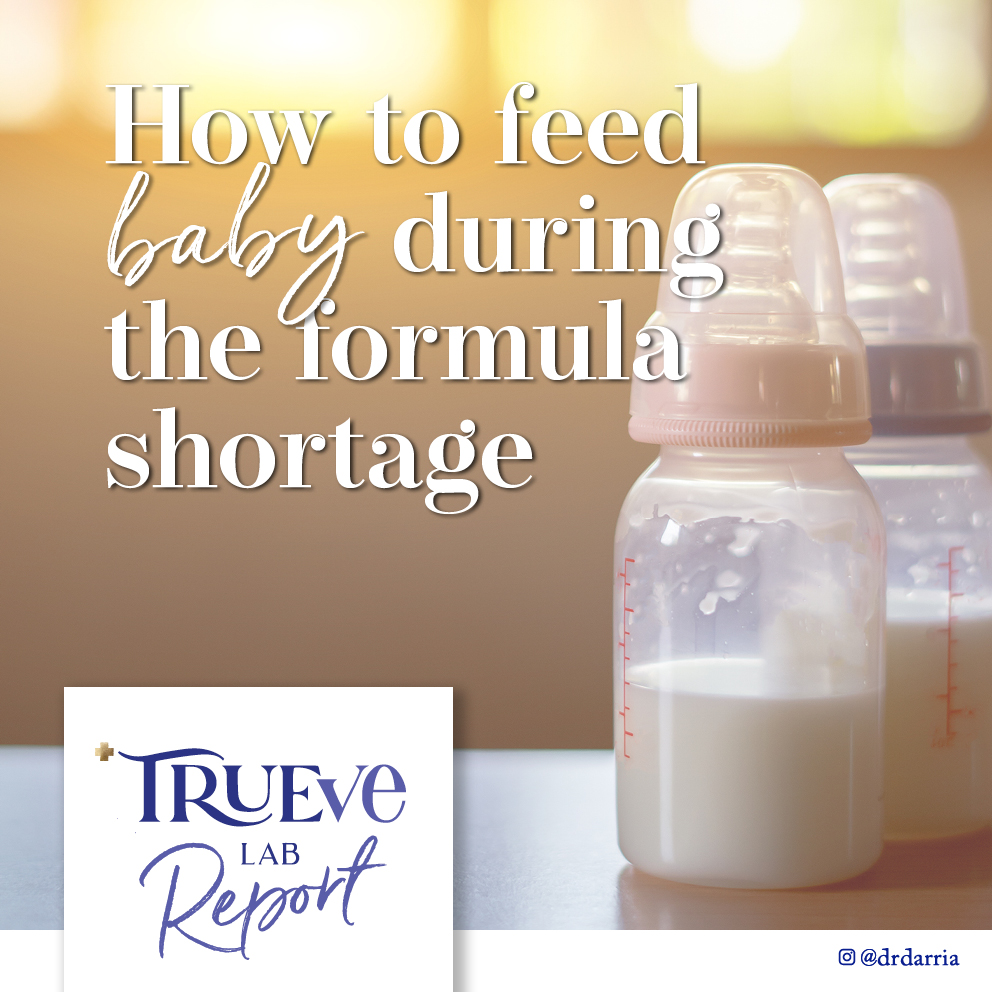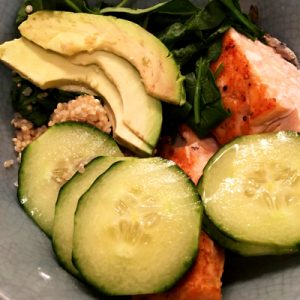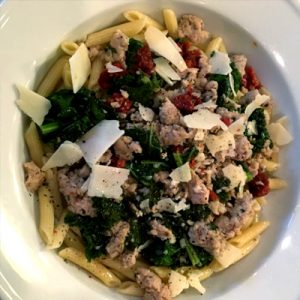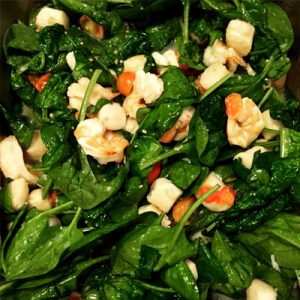How can you feed your infant, when there is a baby formula shortage – not enough of the very food they need?
The idea of not being able to feed my children? Terrifying. To be honest, I’ve never really had to consider it, although my patients do.
Which is why the infant formula shortage crisis in the US is pretty scary, if you think about it. Several of my ER and pediatrician colleagues report a small uptick in ER visits, with parents giving their children watered-down formula, homemade formula, or other substitutes, such as even soy milk or Carnation milk.
Fortunately, with new shipments coming in from Europe and Australia, the shortage will hopefully start to abate – but we don’t expect to see shelves fully restocked until early July.
So, we surveyed some of our TrueveLab advisory board and experts – and here’s what parents can do in the meantime, to make sure that none of our babies, go hungry.
**Now as for policy changes to make sure this doesn’t happen again? That’s a different topic – but one that we cannot forget, when this shortage is over.
Operation Fly Formula – and What’s Being Shipped
While the US traditionally produces almost all of the formula that we consume, the FDA has created a new process to allow for importation of formula from certain companies – all three of which meet the US Infant Formula Act. These include Kendamil, the only UK-made baby milk brand, Bubs Australia, and Nestle NAN SupremePro. According to Dr. Pip Spandorfer, of North Atlanta Pediatrics, he has “no concerns” about what’s being shipped over from Europe. “Moms have been giving their kids those formulas for years in Europe and overseas”. Actually, Prince Louis of Cambridge was also weaned using Kendamil, the UK-made baby milk brand that will be shipped here.
Differences between these and typical brands used in the US:
-
Kendamil and Bubs offer goat milk-based formula. While it’s new to many of us, goat milk is actually consumed more around the world than cow’s milk, and can be easier to digest than dairy. Per Dr. Altmann, “Goat milk infant formula is a safe and a suitable alternative to cow and soy formulas. Several key features in goat milk fat composition have a greater similarity to breast milk compared to cow milk formula, which may be why many parents report that it’s easier for their little ones to digest. It also has lower levels of lactose and only contains only trace amounts of allergenic casein protein that is found in cow milk. “
-
Overseas formulas are likely measured in milliliters, instead of ounces. Most baby bottles have both metrics, just keep an eye out for that good ole metric scale.
Dr. Tanya Altmann, TrueveLab advisor and founder of Calabasas Pediatrics says, “I applaud the FDA has given the green light to high quality international formula brands, like Bubs Australia and Kendamil UK, to help with the shortage…..we want to assure parents that as long as they work with their pediatrician to find a suitable formula substitute, their babies should not experience anything more than a temporary decrease in stool pattern.”
I asked Dr. Altmann if there was anything else she wanted people to know – and what she shared was about as reassuring as we can get – so i wanted to share it all right here: “Bubs Australia is a 17-year-old, publicly traded company, that has safely fed more than a million babies in 10 countries without incident. Bubs controls the entire manufacturing process all the way back to our farm-gates in New Zealand and Australia. Their manufacturing facility in Victoria is FDA-registered and follows very strict regulatory processes put in place by The Food Standard of Australia and New Zealand. Bubs’ formulas are also Clean Label Purity Award recipients which means they’ve been independently tested for over 400 contaminants and toxins and recognized for meeting the highest standards.”
What to do until the baby formula shortage is over
-
-
Places to call for formula supply:
-
Call your pediatrician – many have samples from formula reps that can get you through one week at a time. You can also discuss with them if you can switch to other formulas, that may be more available.
-
Ask a pharmacist – per Dr. Spandorfer, they often have a supply behind the counter, especially of specialty formulas, such as hypoallergenic.
-
Go on facebook, nextdoor, or anywhere in your community to find extras. (and if you HAVE extra, please go on these sites or share any that you no longer need).
-
WIC recipients (Women, Infants, and Children program) can also contact WIC, as they often stock formula.
-
Try non-chain stores or pharmacies, which may have more supply than a big-box store during the baby formula shortage.
-
Church pantries or food banks
-
Head into the store first thing in the morning, ideally right after they’ve stocked their shelves.
-
Breast milk banks
-
-
Embrace imperfect breast-feeding abilities. Many women start to do formula because they struggle to produce enough breast milk. That’s totally ok – but if you are doing it just because you can’t produce 100%, then don’t give up. Even if you’re not able to produce the entire amount that your child needs, if you’re able to produce say, a third, then that’s 1/3 less that you have to buy in formula. Make sure to hydrate to maintain supply, and pump even between feedings (some call this “power pumping” – think of it as weight training for breast-feeding boobs) – more pumping typically stimulates more breast milk to be produced. Check out other resources to increase supply here, here, or here.
-
For children over 6 months:
-
if your baby is older than 6 months and not on a specialty formula, you can give them whole cow’s milk for up to a week until formula is available, per the AAP. While not ideal, the AAP stresses that it’s better than diluting formula or trying to make it homemade.
-
-
For children over 9 months:
-
At 9 months, you can start adding in more table food, and weaning your child off formula a little sooner, according to Dr. Spandorfer
-
-
Consider carefully storing mixed formula for very short periods in the fridge. If you just made 8 ounces, and bambino drank 1, what do you do? The CDC says discard, immediately! But as Emily Oster summed up nicely, while a baby drinking formula does transfer some oral bacteria to the formula, the bacteria levels were relatively stable when left in the fridge, even up to 24 hours. We wouldn’t make this a regular habit, nor suggest going to 24 hours, but saving that amount to give at the next feeding 2-3 hours later (and not mixing it with new formula), seems to have less bacterial load that we may have feared.
-
What NOT to do during the baby formula shortage
-
Do not dilute formula at all. Doing so causes a dilution of the nutrients, but most dangerously can lead to low levels of electrolytes in baby’s blood, which can lead to seizures and death.
-
Give other alternatives, such alternative dairy-free milks that are not created for babies.
-
Don’t make your own formula. Baby formula is made in a very specialized way, to create a special ratio of nutrients, and to also prevent dangerous bacteria from entering the formula.
-
Please don’t stockpile. I fully understand every parent’s urge to do this – heck – I wanted to stockpile toilet paper, and that was just to clean our behinds. Baby formula is far more precious. But please do your best to resist.
More hope in sight – The USDA just announced that it will offer nationwide waivers to increase access to infant formula for families in need as states receive and distribute imported infant formula made available by Operation Fly Formula.








